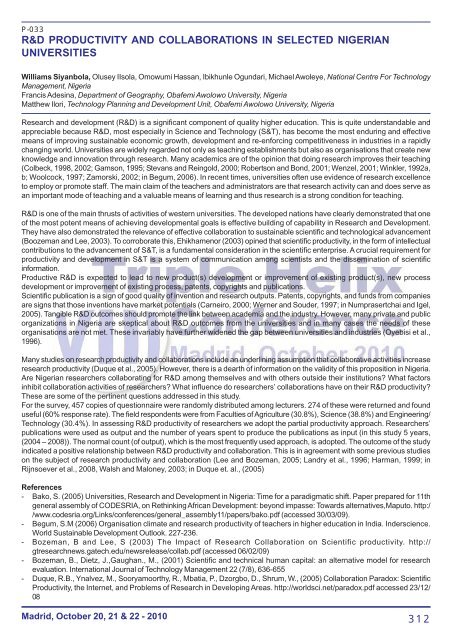TRIPLE HELIX noms.pmd
TRIPLE HELIX noms.pmd
TRIPLE HELIX noms.pmd
You also want an ePaper? Increase the reach of your titles
YUMPU automatically turns print PDFs into web optimized ePapers that Google loves.
P-033R&D PRODUCTIVITY AND COLLABORATIONS IN SELECTED NIGERIANUNIVERSITIESWilliams Siyanbola, Olusey IIsola, Omowumi Hassan, Ibikhunle Ogundari, Michael Awoleye, National Centre For TechnologyManagement, NigeriaFrancis Adesina, Department of Geography, Obafemi Awolowo University, NigeriaMatthew Ilori, Technology Planning and Development Unit, Obafemi Awolowo University, NigeriaResearch and development (R&D) is a significant component of quality higher education. This is quite understandable andappreciable because R&D, most especially in Science and Technology (S&T), has become the most enduring and effectivemeans of improving sustainable economic growth, development and re-enforcing competitiveness in industries in a rapidlychanging world. Universities are widely regarded not only as teaching establishments but also as organisations that create newknowledge and innovation through research. Many academics are of the opinion that doing research improves their teaching(Colbeck, 1998, 2002; Gamson, 1995; Stevans and Reingold, 2000; Robertson and Bond, 2001; Wenzel, 2001; Winkler, 1992a,b; Woolcock, 1997; Zamorski, 2002; in Begum, 2006). In recent times, universities often use evidence of research excellenceto employ or promote staff. The main claim of the teachers and administrators are that research activity can and does serve asan important mode of teaching and a valuable means of learning and thus research is a strong condition for teaching.R&D is one of the main thrusts of activities of western universities. The developed nations have clearly demonstrated that oneof the most potent means of achieving developmental goals is effective building of capability in Research and Development.They have also demonstrated the relevance of effective collaboration to sustainable scientific and technological advancement(Boozeman and Lee, 2003). To corroborate this, Ehikhamenor (2003) opined that scientific productivity, in the form of intellectualcontributions to the advancement of S&T, is a fundamental consideration in the scientific enterprise. A crucial requirement forproductivity and development in S&T is a system of communication among scientists and the dissemination of scientificinformation.Productive R&D is expected to lead to new product(s) development or improvement of existing product(s), new processdevelopment or improvement of existing process, patents, copyrights and publications.Scientific publication is a sign of good quality of invention and research outputs. Patents, copyrights, and funds from companiesare signs that those inventions have market potentials (Carneiro, 2000; Werner and Souder, 1997; in Numprasertchai and Igel,2005). Tangible R&D outcomes should promote the link between academia and the industry. However, many private and publicorganizations in Nigeria are skeptical about R&D outcomes from the universities and in many cases the needs of theseorganisations are not met. These invariably have further widened the gap between universities and industries (Oyebisi et al.,1996).Many studies on research productivity and collaborations include an underlining assumption that collaborative activities increaseresearch productivity (Duque et al., 2005). However, there is a dearth of information on the validity of this proposition in Nigeria.Are Nigerian researchers collaborating for R&D among themselves and with others outside their institutions? What factorsinhibit collaboration activities of researchers? What influence do researchers’ collaborations have on their R&D productivity?These are some of the pertinent questions addressed in this study.For the survey, 457 copies of questionnaire were randomly distributed among lecturers. 274 of these were returned and founduseful (60% response rate). The field respondents were from Faculties of Agriculture (30.8%), Science (38.8%) and Engineering/Technology (30.4%). In assessing R&D productivity of researchers we adopt the partial productivity approach. Researchers’publications were used as output and the number of years spent to produce the publications as input (in this study 5 years,(2004 – 2008)). The normal count (of output), which is the most frequently used approach, is adopted. The outcome of the studyindicated a positive relationship between R&D productivity and collaboration. This is in agreement with some previous studieson the subject of research productivity and collaboration (Lee and Bozeman, 2005; Landry et al., 1996; Harman, 1999; inRijnsoever et al., 2008, Walsh and Maloney, 2003; in Duque et. al., (2005)References- Bako, S. (2005) Universities, Research and Development in Nigeria: Time for a paradigmatic shift. Paper prepared for 11thgeneral assembly of CODESRIA, on Rethinking African Development: beyond impasse: Towards alternatives,Maputo. http://www.codesria.org/Links/conferences/general_assembly11/papers/bako.pdf (accessed 30/03/09).- Begum, S.M (2006) Organisation climate and research productivity of teachers in higher education in India. Inderscience.World Sustainable Development Outlook. 227-236.- Bozeman, B and Lee, S (2003) The Impact of Research Collaboration on Scientific productivity. http://gtresearchnews.gatech.edu/newsrelease/collab.pdf (accessed 06/02/09)- Bozeman, B., Dietz, J.,Gaughan., M., (2001) Scientific and technical human capital: an alternative model for researchevaluation. International Journal of Technology Management 22 (7/8), 636-655- Duque, R.B., Ynalvez, M., Sooryamoorthy, R., Mbatia, P., Dzorgbo, D., Shrum, W., (2005) Collaboration Paradox: ScientificProductivity, the Internet, and Problems of Research in Developing Areas. http://worldsci.net/paradox.pdf accessed 23/12/08Madrid, October 20, 21 & 22 - 2010312










